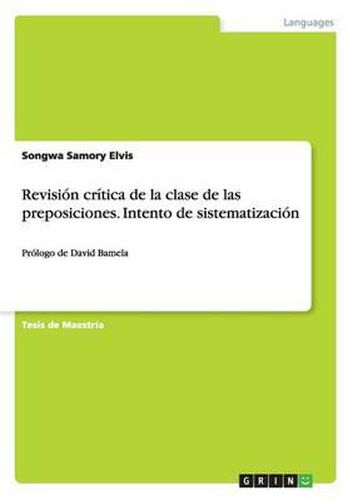Readings Newsletter
Become a Readings Member to make your shopping experience even easier.
Sign in or sign up for free!
You’re not far away from qualifying for FREE standard shipping within Australia
You’ve qualified for FREE standard shipping within Australia
The cart is loading…






Tesis de Maestria del ano 2012 en eltema Romanistica - Estudios espanoles, Universite de Douala, Idioma: Espanol, Resumen: In this investigation, we study spanish prepositions and what is generally said about them. Before, prepositions were considered as a part of the class of conjunctions. Finally, Dionisio de Tracia was who made independents prepositions as a class of words. From then on, they became a subject of study. In their description, they have three mains characteristics: the preposition as connecting element, subordinator and transpositor element. The class of preposition is considered as a closed class. It has a number of elements relatively fixed; and sometimes, some of them are discussed. Studying the prepositions syntax, we draw the following conclusions: postponed prepositions don't exist; elements of different classes, not only substantives, can be term of preposition; the preposition by itself cannot be regent in any sequence; the sylleptic construction enriches the language, so that it shouldn't be reprimanded; the prepositional syntagm has some nucleus different from the one of the nominal syntagm. The subject function is incompatible with preposition; the grouped prepositions don't exist, but prepositional constructions can be introduced by other preposition; inseparable prepositions are simply prefix or suffix. We classified them into strong and weak. Into the weak ones, there are simple and complex forms. A veritable preposition should sum the following characteristics: be invariable, always goes before, be transpositor, free morpheme and not accentuated.
$9.00 standard shipping within Australia
FREE standard shipping within Australia for orders over $100.00
Express & International shipping calculated at checkout
Tesis de Maestria del ano 2012 en eltema Romanistica - Estudios espanoles, Universite de Douala, Idioma: Espanol, Resumen: In this investigation, we study spanish prepositions and what is generally said about them. Before, prepositions were considered as a part of the class of conjunctions. Finally, Dionisio de Tracia was who made independents prepositions as a class of words. From then on, they became a subject of study. In their description, they have three mains characteristics: the preposition as connecting element, subordinator and transpositor element. The class of preposition is considered as a closed class. It has a number of elements relatively fixed; and sometimes, some of them are discussed. Studying the prepositions syntax, we draw the following conclusions: postponed prepositions don't exist; elements of different classes, not only substantives, can be term of preposition; the preposition by itself cannot be regent in any sequence; the sylleptic construction enriches the language, so that it shouldn't be reprimanded; the prepositional syntagm has some nucleus different from the one of the nominal syntagm. The subject function is incompatible with preposition; the grouped prepositions don't exist, but prepositional constructions can be introduced by other preposition; inseparable prepositions are simply prefix or suffix. We classified them into strong and weak. Into the weak ones, there are simple and complex forms. A veritable preposition should sum the following characteristics: be invariable, always goes before, be transpositor, free morpheme and not accentuated.